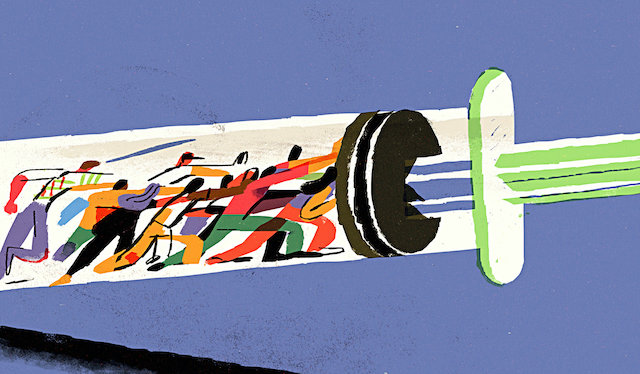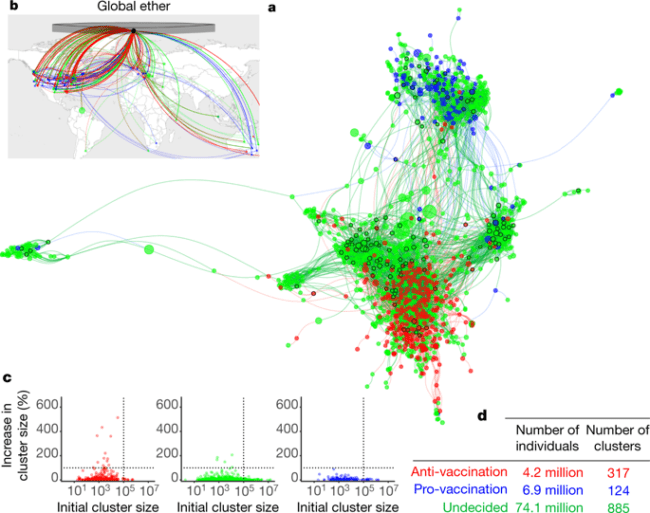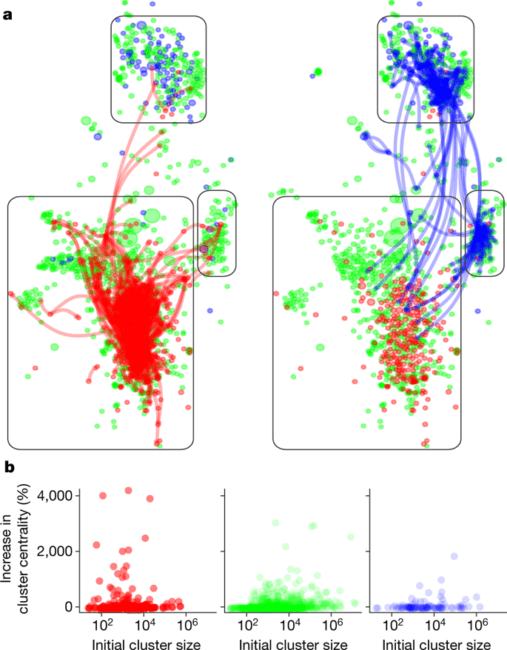
A newly published paper explores the vaccine information battle taking place online. It is between robust evidence-based facts on vaccinations vs anti-vaccination myths.
Why does this matter?
We live in a world where resistance to the use of a vaccine for COVID-19 will have dire fatal consequences for many people.
The paper has been published within Nature on 13th May 2020 and lays out the details of research conducted at George Washington University.
Nature (May 13 2020): The online competition between pro- and anti-vaccination views
Distrust in scientific expertise is dangerous.
If many people oppose vaccination with a future vaccine against SARS-CoV-2, the causal agent of COVID-19, then future outbreaks could be amplified. This is not an abstract theory, we have seen this happen last year with the 2019 measles outbreak.
What we have is the emergence of online communities where homemade remedies and falsehoods are being shared widely along with dismissal of evidence and expert-based advice.
What exactly does this paper do?
They explain it like this …
Here we provide a map of the contention surrounding vaccines that has emerged from the global pool of around three billion Facebook users. Its core reveals a multi-sided landscape of unprecedented intricacy that involves nearly 100 million individuals partitioned into highly dynamic, interconnected clusters across cities, countries, continents and languages.
Although smaller in overall size, anti-vaccination clusters manage to become highly entangled with undecided clusters in the main online network, whereas pro-vaccination clusters are more peripheral. Our theoretical framework reproduces the recent explosive growth in anti-vaccination views, and predicts that these views will dominate in a decade. Insights provided by this framework can inform new policies and approaches to interrupt this shift to negative views.
Our results challenge the conventional thinking about undecided individuals in issues of contention surrounding health, shed light on other issues of contention such as climate change11, and highlight the key role of network cluster dynamics in multi-species ecologies15
Their Map
Here is their snapshot of a moment in time …

a, In the above the item marked a. (that blob on the upper right-hand side), is a snapshot from 15 October 2019 of the connected component in the complex ecology of undecided (green), anti-vaccination (red) and pro-vaccination (blue) views comprising nearly 100 million individuals in clusters (pages) associated with the vaccine topic on Facebook. The colour segregation is an emergent effect (that is, not imposed). Cluster sizes are determined by the number of members of the Facebook page. Black rings show clusters with more than 50% out-link growth. Each link between nodes has the colour of the source node.
b, This shows the Global spread of a for a small number of clusters. The ‘global ether’ represents clusters that remain global (grey).
c, This shows that Anti-vaccination clusters have a stronger growth in cluster size. Each coloured dot is a node; data are from February–October 2019.
d, This illustrates that Anti-vaccination individuals are an overall numerical minority compared with pro-vaccination individuals; however, anti-vaccination individuals form more separate clusters
How it then plays out
They then build on all of the above and give an illustration of how this plays out over time as follows …

a, Link growth during February–October 2019 for anti-vaccination (red; left) and pro-vaccination (blue; right) clusters. Anti-vaccination clusters successfully added many new links within the largest network patch and between network patches, despite the media ambience against anti-vaccination views during the measles outbreak in 2019. The underlying clusters are identical to Fig. 1a, that is, each network patch is a clustered region of clusters from Fig. 1a.
b, Anti-vaccination clusters have a stronger growth in node eigencentrality—which indicates the influence of a node in a network—than pro-vaccination clusters. Data are from February–October 2019.
Key Points
They put 100 million facebook users into one of three categories …
- red = anti-vaccination
- blue = pro-vaccination
- green = undecided
Then put them into clusters (people in the same Facebook group who interact) and over time they can then see what happens.
They discovered that …
- The total number of anti-vaccination people was smaller that pro-vaccination …. but … there are 3 times the number of anti-vaccination clusters … hence they had a far greater reach to the undecided
- This left the pro-vaccination clusters on the edge and not really reaching the undecided
- They also observed that pro-vaccination communities which focused on countering larger anti-vaccination communities may be missing medium-sized ones growing under the radar
The researchers also found anti-vaccination communities offer more diverse narratives around vaccines and other established health treatments — promoting safety concerns, conspiracy theories or individual choice, for example — that can appeal to more of Facebook’s approximately 3 billion users, thus increasing the chances of influencing individuals in undecided communities. Pro-vaccination communities, on the other hand, mostly offered monothematic messaging typically focused on the established public health benefits of vaccinations.
Comments by the researchers
Professor Neil Johnson who led the research team …
“There is a new world war online surrounding trust in health expertise and science, particularly with misinformation about COVID-19, but also distrust in big pharmaceuticals and governments,” Dr. Johnson said. “Nobody knew what the field of battle looked like, though, so we set to find out.”
“We thought we would see major public health entities and state-run health departments at the center of this online battle, but we found the opposite. They were fighting off to one side, in the wrong place,”
“Instead of playing whack-a-mole with a global network of communities that consume and produce (mis)information, public health agencies, social media platforms and governments can use a map like ours and an entirely new set of strategies to identify where the largest theaters of online activity are and engage and neutralize those communities peddling in misinformation so harmful to the public,” Dr. Johnson said.
The COVID-19 Impact
As scientists around the world scramble to develop an effective COVID-19 vaccine, the spread of health disinformation and misinformation has important public health implications, especially on social media, which often serves as an amplifier and information equalizer.
In their study, the researchers proposed several different strategies to fight against online disinformation, including influencing the heterogeneity of individual communities to delay onset and decrease their growth and manipulating the links between communities in order to prevent the spread of negative views.
Doing nothing is not an option
Anti-vaccination clusters show the highest growth during the measles outbreak of 2019, whereas pro-vaccination clusters show the lowest growth.
Some anti-vaccination clusters grow by more than 300%, whereas no pro-vaccination cluster grows by more than 100% and most clusters grow by less than 50%. This is consistent with the anti-vaccination population being able to attract more undecided individuals by offering many different types of cluster, each with its own type of negative narrative regarding vaccines.
Medium-sized anti-vaccination clusters grow most. Whereas larger anti-vaccination clusters take up the attention of the pro-vaccination population, these smaller clusters can expand without being noticed
The complex cluster dynamics between undecided, anti-vaccination and pro-vaccination individuals mean that traditional mass-action modelling cannot be used reliably for predictions or policies.
Under the present conditions, their model predicts that total anti-vaccination support reaches dominance in around 10 years.
These findings suggest a new theoretical framework to describe this ecology, and inform new policies that allow pro-vaccination entities, or the platform itself, to choose their preferred scale at which to intervene.
Further Reading
- Nature (13 May 2020) – The online competition between pro- and anti-vaccination views
- Press Release
